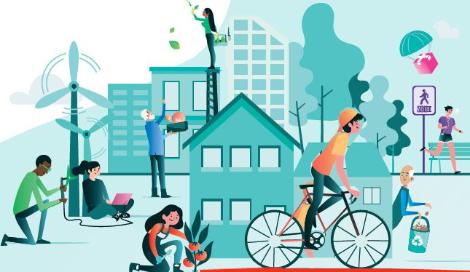Tomorrow my territory 15 Planning my territory in a sustainable way
Sustainable development
November 2019
Agence pour l’Environnement et la Maîtrise de l’Energie (ADEME)
The 20 factsheets in the collection « demain MON TERRITOIRE » have been designed to give candidates and elected officials practical keys to take action, to open up the field of possibilities based on the experiences of other elected officials, from small towns to conurbations, large urban areas or sparsely populated areas. In the four corners of France, both in metropolitan France and in the French Overseas Territories, many of them are taking action, together with the players in their territories, to prepare for the future by taking action to mitigate climate change and adapt to its effects. With its knowledge and presence throughout the country, ADEME supports them with its tools, activities and financial aid.

Why is rethinking urban planning important?
The French are now experiencing the consequences of an often unbridled urban expansion. Distances between home and work mean long, costly and polluting journeys. Local shops are disappearing in favour of vast commercial zones on the outskirts. Conversely, density aimed at limiting urban sprawl can be synonymous with sustainability, proximity of services and quality of life. In the face of population growth, urban planning must be rethought. And to think about developments that respect the principles of sustainable development. They must help to reduce energy consumption, make the air cleaner, preserve biodiversity, reduce the artificialization of natural and agricultural soils and urban overheating, and participate in the fight against climate change.
How do you do it?
-
Over the past 10 years, the legislative framework has given a boost to communities with the « Sustainable City » plan and its programs on eco-neighbourhoods, the revitalization of town centres and nature in the city.
-
Before launching urban planning projects, we take a step aside to think about their impact. What needs and uses do they correspond to? We question the environmental dimension of these future developments. Is the location adapted to the expected uses? What services are planned to limit unnecessary travel? Building requires resources. Can their use be limited? Is it possible to replace conventional materials with bio-sourced or recycled materials? New developments consume energy. How can this consumption be reduced? What place should be given to renewable energies and which ones?
-
The energy and ecological transition is better integrated into all urban renewal and revitalisation programmes, such as those dedicated to town centres, by using the approaches and tools of the sustainable city (Eco-Quartier label, AEU2® approach, etc.).
-
The environmental preservation approach is at the heart of urban planning and development projects. In concrete terms, the documents of the municipal (PLU) and inter-municipal (SCOT and PLUi) strategic planning (PLU), as well as the regulations of the Zones d’Aménagement Concertées (ZAC), integrate requirements on the deployment of green and blue frames, the organisation of soft modes of transport, density, the production of renewable energies, adaptation to climate change, etc.
-
We are putting a stop to the artificialisation of the soil and are putting in place compensatory measures to renature the spaces. Other solutions are favoured to ensure local development, such as the conversion of brownfield sites or the use of vacant housing. Nature and/or new economic activities are brought into deserted former industrial sites, for example by installing photovoltaic power generation parks.